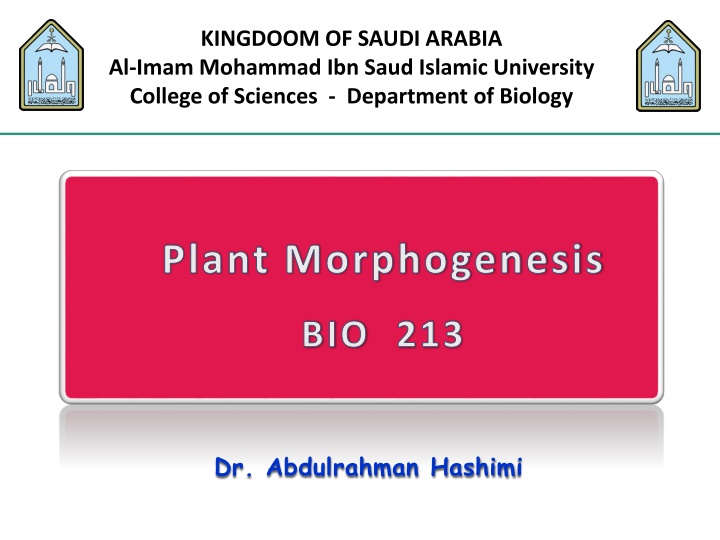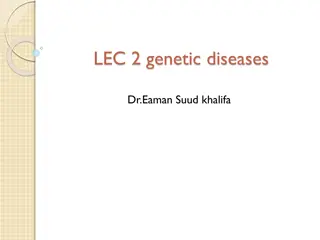
Plant Defense Mechanisms: Surface Protection and Secondary Metabolites
Explore how plants defend against herbivores and pathogens through surface protection and secondary metabolites. Learn about the role of cutin, suberin, and waxes in plant defense, along with physical defenses like thorns and prickles.
Download Presentation

Please find below an Image/Link to download the presentation.
The content on the website is provided AS IS for your information and personal use only. It may not be sold, licensed, or shared on other websites without obtaining consent from the author. If you encounter any issues during the download, it is possible that the publisher has removed the file from their server.
You are allowed to download the files provided on this website for personal or commercial use, subject to the condition that they are used lawfully. All files are the property of their respective owners.
The content on the website is provided AS IS for your information and personal use only. It may not be sold, licensed, or shared on other websites without obtaining consent from the author.
E N D
Presentation Transcript
KINGDOOM OF SAUDI ARABIA Al-Imam Mohammad Ibn Saud Islamic University College of Sciences - Department of Biology Plant Morphogenesis BIO 213 Dr. Abdulrahman Hashimi
Lecture 10 Plant Defense Systems Surface protection Secondary metabolites Defense against pathogens
Introduction Nearly all ecosystems contain a wide variety of bacteria, viruses, fungi, nematodes, mites, insects, mammals, and other herbivory (Herbivory are animals eating plants). Plants cannot avoid these herbivores and pathogens simply by moving away; they must protect themselves in other ways. Plants use defense systems to ; 1. deter herbivory, 2. prevent infection, 3. combat pathogens.
Introduction Plants counter excessive herbivory with physical defenses such as thorns and chemical defenses such as toxic compounds. Some plants use predatory animals that help defend against specific herbivores. Plants can use several strategies to defend against damage caused by herbivores and pathogens , including; 1. Surface protection 2. Secondary metabolites
Surface protection Some plants have hard structures with sharp ends on their surface, such as Spines, Prickles, and Thorns, They are extensions or modifications of leaves, stems or buds, which physically protect plants against herbivores.
Surface protection All plant parts exposed to the atmosphere are coated with layers of lipid materials that reduce water loss and help block the entry of pathogenic fungi and bacteria. The principal types of coatings are ; 1. Cutin : found on most aboveground parts. 2. Suberin : suberin is present on underground parts, woody stems, and healed wounds. 3. Waxes : associated with both cutin and suberin.
Cutin The cutin is a macromolecule, a polymer consisting of many long-chain fatty acids that are attached to each other by ester linkages, creating a rigid three-dimensional network. The cutin is a major component of plant cuticle. The cuticle is a multilayered secreted structure that coats the outer cell wall of epidermis on the areal parts
Cutin Structure of Plant cuticle The cuticle is composed of: 1- a top coating of wax, 2- a thick middle layer containing cutin embedded in wax (the cuticle proper), and a lower layer formed of cutin and wax blended with the cell wall substances pectin, cellulose, and other carbohydrates (the cuticular layer).
Waxes The waxes are complex mixtures of long-chain lipids that are extremely hydrophobic. The most common components of waxes are straight chain alkanes and alcohol of 25 to 35 carbon atoms. They are synthesized by epidermal cells. They leave the epidermal cells as droplets that pass through pores in the cell wall.
Suberin Suberin is also formed from fatty acids but has a different structure from cutin. Suberin is a principal component of the outer cell walls of all underground organs. Older parts of roots more suberized. Suberin is present in the Casparian strip of root endodermis. Suberin is also found at sites of leaf abscission and in areas damaged by disease or wounding.
Cutin, Suberin and Waxes Cutin, suberin, waxes are made of hydrophobic compounds. They form barriers between the plant and its environment that function to keep water in and pathogens out. The cuticle and suberized tissue are important in excluding fungi and bacteria. However, many fungi can penetrate directly through the plant surface by mechanical means, and others fungi produce the cutinase enzyme that hydrolyzes cutin and thus facilitates entry of the pathogen into the plant.
Secondary metabolites Secondary metabolites are organic compounds that are not involved in primary pathways of growth and development. They have no direct function in photosynthesis or respiration. However, they have important functions in plants: 1. protect primary metabolism by deterring herbivores, reduce tissue loss. 2. protect plants against microbial pathogens. 3. attract pollinators and seed-dispersing animals.
Secondary metabolites Plant secondary metabolites can be divided into three groups: 1. Terpenes , lipid synthesized from acetyl CoA or from basic intermediates of glycolysis. 2. Phenolic compounds , aromatic substances formed by the shikimic acid pathway or the malonic acid pathway . 3. Nitrogen containing secondary products (alkaloids) , alkaloids which are synthesized primary from amino acids.
Terpenes The terpenes, or terpenoids, constitute the largest class of secondary products. They are organic components, generally insoluble in water. They produced by the mevalonic acid pathway from the acetyl-CoA or glycolytic intermediates. They produced in response to herbivores feeding, to attract predatory insects and parasites of the feeding herbivores. Terpenes are toxins and feeding deterrents to many plant feeding insects and mammals.
Terpenes Terpenes are major components of the plant essential oils. Many terpenes are used as human medicinal drugs. Terpenes are derived from the 5-carbon alkene isoprene. (thus, the terpenes also called isoprenoids ).
Terpenes Terpenes are classified based on the number of 5-carbon units (isoprene units) they contain into : 1. Monoterpenes have 2 isoprene units (10-Carbons) 2. Sesquiterpenes have 3 isoprene units (15-Carbons) 3. Diterpenes have 4 isoprene units (20-Carbons) 4. Triterpenes have 6 isoprene units (30-Carbons) 5. Tetraterpenes have 8 isoprene units (40-Carbons) 6. Polyterpenes have >8 isoprene units (> 40-Carbons)
Terpenes Examples of plant terpene 1. Limonene is a non-volatile monoterpene, a major component in oil of citrus fruit peels, and known as distasteful to herbivores. 2. Menthol is a volatile monoterpene, produced by various plants (especially mint). Menthol is a smell that warns herbivores that the plant is toxic to them before herbivore feeding commences. 3. Saponins are type of triterpenes, produced by plants as a part of their self-defense mechanism. They are toxins and act as feeding deterrents to species of mites, beetles and other insects.
Terpenes Examples of plant terpene Non-volatile Terpenes Volatile Terpenes
Phenolic compounds Phenolics (or phenols) are aromatic benzene ring compounds with one or more hydroxyl groups. They produced by plants as defense compounds against herbivores and pathogens. Others functions of the phenolic compounds are: 1. providing mechanical support. 2. attracting pollinators and fruit dispersers. 3. absorbing harmful ultraviolet radiation. 4. reducing the growth of nearby competing plants.
Phenolic compounds Classification of Phenolic Compounds
N-containing secondary compounds They are less common in plants than Terpenes and Phenolics. They are synthesized from aliphatic and aromatic amino acids. Classes of N-containing secondary compounds : 1. Alkaloids 2. Cyanogenic glycosides 3. Glucosinolates 4. Non-protein amino acids
N-containing secondary compounds 1- Alkaloids The most important nitrogen containing secondary products. Most effective at deterring mammalian herbivores. Livestock deaths due to over-consumption of alkaloid containing plants such as lupines and groundsels. Often alkaloids are used as medicines for humans. Some examples: morphine, codeine, and scopolamine. Cocaine nicotine, and caffeine used as stimulants and sedatives.
N-containing secondary compounds 1- Alkaloids
N-containing secondary compounds 1- Alkaloids The tobacco plants (Nicotianaspp.) normally produces nicotine in response to herbivore feeding. But if nicotine-tolerant caterpillars are feeding, the tobacco produces terpenes instead. These terpenes can attract the predators of the herbivore.
N-containing secondary compounds 2- Cyanogenic glycosides The plants convert these compounds into the toxic gas hydrogen cyanide (HCN) in response to herbivore feeding. Plants that produce cyanogenic glycosides also produce the enzymes that convert these compounds into hydrogen cyanide, including glycosidases and hydroxynitrile lyases. These enzymes and are stored in separate compartments or tissues within the plant; when herbivores feed on these tissues, they produce the lethal hydrogen cyanide.
N-containing secondary compounds 2- Cyanogenic glycosides The degradation process of Cyanogenic glycosides
N-containing secondary compounds 2- Cyanogenic glycosides The cassava plants (Manihotesculenta), which originated in South America, has high levels of cyanogenic glycosides.
N-containing secondary compounds 3- Glucosinolates These compounds release volatile defensive substances, mustard oils , (often herbivore repellents). Plants like cabbage, broccoli, and radishes (Brassicaceaefamily) have these compounds. Glucosinolates are sulfur- and nitrogen-containing secondary metabolites involved in plant defense against herbivores. Glucosinolates are present constitutively in plant tissues, but are also induced to higher levels by herbivores attack.
N-containing secondary compounds 4- Non-protein amino acids These amino acids are not incorporated into proteins but instead act as protective substances. They can mistakenly be incorporated into protein and therefore resulting in a nonfunctional protein. Non-protein amino acids and their protein amino acids analogs
Functions of Secondary Metabolites in Plants 1. They make a valuable contribution to the relationship between plant and their environment. 2. Plant utilized secondary metabolites as antibiotics or signaling agent during the interaction with pathogens. 3. They play an important role in two resistance strategies: A. Structural level, phenyl propanoids are the major component of the cell wall polymers lignin and suberin. B. Inducible defense antibiotics, which originated mainly from phenolics and terpenoids (phytoalexins).
Plant Defense against pathogens Several classes of secondary metabolites have strong antimicrobial activity against pathogens (fungi, bacteria, viruses, nematodes), that are present in the environment. Plant defenses can be classified as constitutive or induced ; 1- Constitutive defense, the antimicrobial compounds are always present in the plant, synthesized before pathogen attack. 2- Induced defense , induced by herbivore attack or microbial infection, they must be activated quickly to be effective.
Plant Defense against pathogens After being infected by a pathogen, plants deploy a broad spectrum of defenses against invading microbes. A common defense is the hypersensitiveresponse, in which the cells immediately surrounding the infection site die rapidly, depriving the pathogen of nutrients and preventing its spread. After a successful hypersensitive response, a small region of dead tissue is left at the site of the attempted invasion, but the rest of the plant is unaffected.
Plant Defense against pathogens Another defensive response to infection is the formation of hydrolyticenzymes that attack the cell wall of the pathogen. Fore examples, glucanases, chitinases, and other hydrolases are induced by fungal infection. These hydrolytic enzymes belong to a group of proteins that are closely associated with pathogen infection and so are known as pathogenesis-related (PR) proteins.
Plant Defense against pathogens Phytoalexins are a diverse group of secondary metabolites with strong antimicrobial activity that accumulate around the site of infection. Phytoalexins are generally undetectable in the plant before infection, but they are synthesized very rapidly after microbial attack, by activation of new biosynthetic pathways. Phytoalexin production is a common mechanism of resistance to pathogenic microbes in a wide range of plants. However, different plant families employ different types of secondary products.
Plant Defense against pathogens In addition, plants employ specific recognition and signaling systems enabling the rapid detection of pathogen invasion and initiation of a vigorous defensive response. Once infected, some plants also develop an immunity to subsequent microbial attacks. However, many species of herbivores and microbes have evolved the ability to feed on or infect plants containing secondary products without being adversely affected, this herbivores and pathogen stresses has been used for the identification for new defensive products in plants.
Importance of Studying Secondary metabolites Many of these metabolites are employed commercially as insecticides, fungicides, and pharmaceuticals, while others are used as fragrances, flavorings, medicinal drugs, and industrial materials. The breeding of increased levels of secondary metabolites into crop plants has made it possible to reduce the need for certain costly and potentially harmful pesticides. In some cases, however, it has been necessary to reduce the levels of naturally occurring secondary metabolites to minimize toxicity to humans and domestic animals.
Any QUESTIONS ?



![Lec [2] Health promotion](/thumb/274962/lec-2-health-promotion-powerpoint-ppt-presentation.jpg)